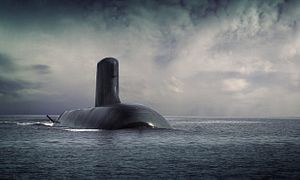Australia’s former Ambassador to the United States and onetime Defense Minister, Kim Beazley, voiced his concerns in a recent report prepared by the Australian Strategic Policy Institute (ASPI) that rapid advancements in underwater military technology might make the Royal Australian Navy’s (RAN) future submarine fleet obsolete much sooner than Australia’s defense ministry is anticipating.
In April 2016, Australia awarded a $50 billion ($38.8 billion) contract–Australia’s largest defense deal ever–to French ship-maker Direction des Constructions Navales Services (DCNS) for the design and construction of 12 Shortfin Barracuda Block 1A submarines, a diesel-electric derivative of DCNS’ Barracuda-class nuclear attack submarine under the RAN’s so-called SEA 1000 Future Submarine Programme.
According to Australia’s 2016 Defense White Paper, the first new submarines are slated to enter service in the 2030s, with construction of the sub fleet extending into the 2030s and 2040s. “A rolling acquisition program will ensure that Australia is able to maintain a fleet of 12 regionally superior submarines as submarine and anti-submarine technologies develop over the coming decades,” the white paper notes.
However, Beazley thinks that long-term projections for defense acquisition purposes are increasingly difficult to make. “Our strategic environment has so many uncertainties in it, and material defense capabilities are so situated in a revolutionary moment, that no 20+-year projection can survive more than two or three years as a source of certainty for policymakers,” Beazley writes in the ASPI report’s preface.
“Artificial intelligence, autonomous systems, direct energy weapons, and applications of those changes in space and underwater systems in particular, disturb not only our priorities but the viability and relevance of some very expensive platforms,” he notes. “One wonders, for example, about the long-term prospect of SEA 1000 when strides seem at last to be made on the use of autonomous systems in underwater detection.”
According to Australian media reports, however, Beazley does not advocate scrapping the SEA 1000 program. He merely wishes to raise some important questions about Australia’s largest defense deal in history. “Technologies in the military sphere are about to change dramatically, and the comfort that we have with [contemporary capabilities] … could very well become an obsolete one, well short of the time limitation they have permitted themselves in the white paper,” he said, according to the The Canberra Times.
The major questions is “not so much will the money be there, but will the technologies be right … it’s a warning flag [on the submarines] and just about everything else we do,” he added.
As I reported previously, there is indeed a major revolution in undersea warfare in the works with the introduction of unmanned underwater vehicles (UUVs), new weapons systems, and new submarine detection technology. For example, large manned submarines could increasingly become host platforms—motherships—for autonomous or semi-autonomous weapons systems similar to aircraft carriers on the surface. Should this become a reality in the next decades, the Shortfin Barracuda Block 1A submarine might prove too small for the role of an underwater aircraft carrier for weaponized UUVs.
































